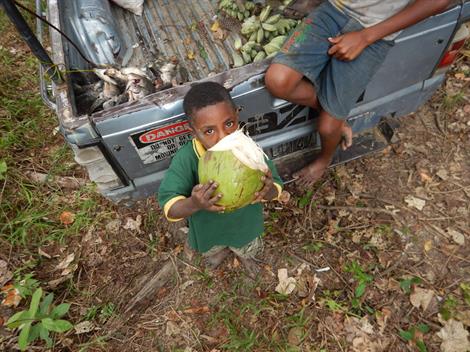The Quest for Wakonai!
part 3 of Sylvain's adventures in Papua New Guinea
part 3 of Sylvain's adventures in Papua New Guinea
The following days are the same, prospecting in the bush but still finding nothing.
Meanwhile here is a small panorama of the concession which is my new home.
Meanwhile here is a small panorama of the concession which is my new home.
Click photos to enlarge!
Saturday 6th September we took a utility vehicle into the bush. The pretext was the search of wild citrus. In fact it turned out to be more of a "boys day out."
Fishing with nets and beaters.
The catch.
Nest of a megapode, 4 m high and 8 m wide! They rushed to dig in the hope of finding the eggs, but they found nothing.
From Wikipedia:
Megapodes are mainly solitary birds that do not incubate their eggs with their body heat as other birds do, but bury them. Also known in Australia as 'Brush Turkeys'.
Megapodes are mainly solitary birds that do not incubate their eggs with their body heat as other birds do, but bury them. Also known in Australia as 'Brush Turkeys'.
This cross-section of a megapode mound shows a layer of sand (up to 1 m thick) used for insulation, an egg chamber, and a layer of rotting compost. The egg chamber is kept at a constant 33°C by opening and closing air vents in the insulation layer, while heat comes from the compost below.

The picnic - cooked bananas, grilled fish and coconut milk to drink.The rifle wasn't used, so no meat. On the way back, we twice passed kangaroos but the hunter on the pick-up truck was not fast enough.
On our return in the evening, a woman brought branches of citrus. Seeing the fruits, I immediately knew that this was the one I had been searching for!
Click photos to enlarge!
So the information on Citrus Pages is wrong. It'll be easy to correct.
Note from Translator/Editor/Mike/Citrange:
I think the information on the 'Citrus Pages' website is only partially incorrect. In fact it is one picture supplied by Saga University that is incorrect in showing round fruits. The UCR Citrus Variety Collection, growing seedlings from the original importation into Florida, also shows fruits that are 'too fat'. My website here includes images showing the correct fruit. I have also seen fruits identical to the one found by Sylvain growing in a nusery in Sicily which distributes the species throughout Europe as pot plants. The Italian plants also originated from Florida seeds. It seems to me that C. wintersii hybridises easily to produce fatter, rounder and yellower fruits.
I think the information on the 'Citrus Pages' website is only partially incorrect. In fact it is one picture supplied by Saga University that is incorrect in showing round fruits. The UCR Citrus Variety Collection, growing seedlings from the original importation into Florida, also shows fruits that are 'too fat'. My website here includes images showing the correct fruit. I have also seen fruits identical to the one found by Sylvain growing in a nusery in Sicily which distributes the species throughout Europe as pot plants. The Italian plants also originated from Florida seeds. It seems to me that C. wintersii hybridises easily to produce fatter, rounder and yellower fruits.
.

A small detail that was a little annoying, is that we immediately realised that it was the plant that we had already seen on Tuesday!
But there was no fruit and the plant had seemed so different from the pictures found on the internet ...
But there was no fruit and the plant had seemed so different from the pictures found on the internet ...
So, C. wintersii (previously called Microcitrus papuana), the Brown River finger lime, has been found. One out of my challenge to find five species! After one week, I'm on time.
Already one ambiguity is cleared up. The wintersii which is grown in the United States is not true to type. Later I had the opportunity to show local people pictures of the round fruits said to be produced by this species. They say they have never seen round fruits in the region. They also claim to have never seen the yellow fruit.
(This refers to the fact that Sylvain is now editor of the 'Citrus Pages' website)











